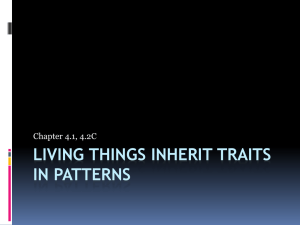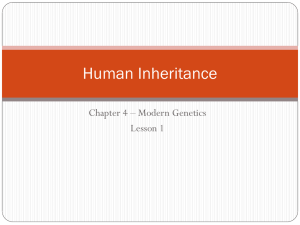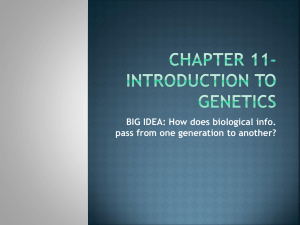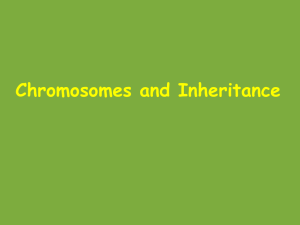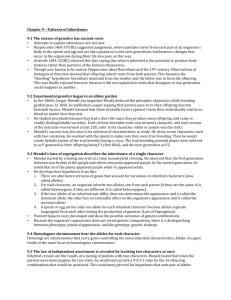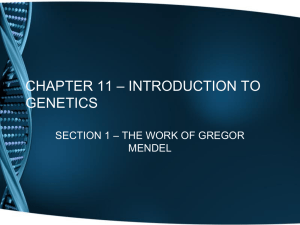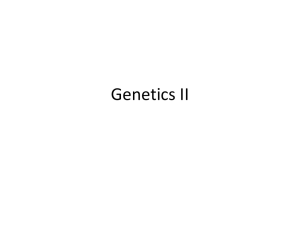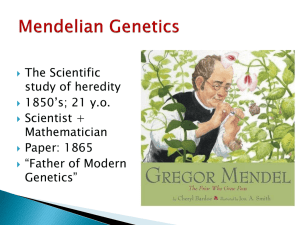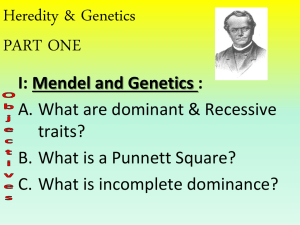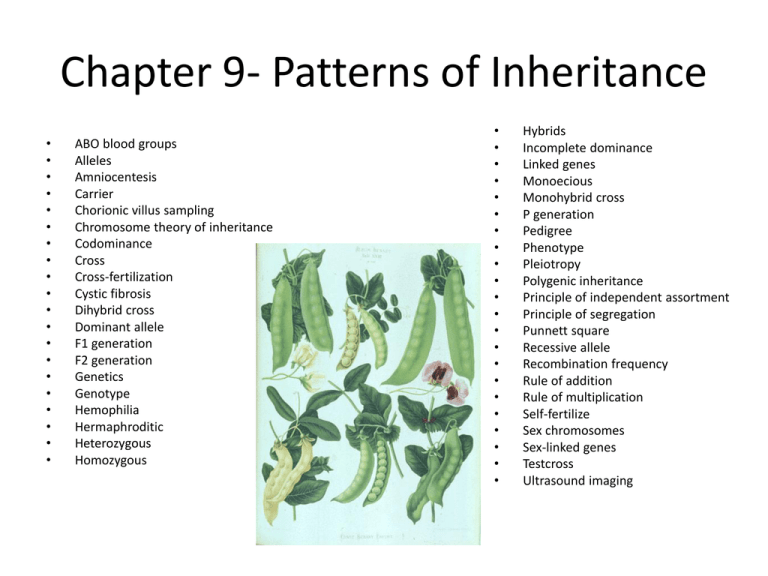
Chapter 9- Patterns of Inheritance
•
•
•
•
•
•
•
•
•
•
•
•
•
•
•
•
•
•
•
•
ABO blood groups
Alleles
Amniocentesis
Carrier
Chorionic villus sampling
Chromosome theory of inheritance
Codominance
Cross
Cross-fertilization
Cystic fibrosis
Dihybrid cross
Dominant allele
F1 generation
F2 generation
Genetics
Genotype
Hemophilia
Hermaphroditic
Heterozygous
Homozygous
•
•
•
•
•
•
•
•
•
•
•
•
•
•
•
•
•
•
•
•
•
•
Hybrids
Incomplete dominance
Linked genes
Monoecious
Monohybrid cross
P generation
Pedigree
Phenotype
Pleiotropy
Polygenic inheritance
Principle of independent assortment
Principle of segregation
Punnett square
Recessive allele
Recombination frequency
Rule of addition
Rule of multiplication
Self-fertilize
Sex chromosomes
Sex-linked genes
Testcross
Ultrasound imaging
Genetics
• Study of heredity
Gregor Mendel
• Monk, father of modern
genetics, 1860’s
• Discovered genetic
principles by meticulous
breeding of pea plants
• Used peas because they
were readily available,
easy to grow, had many
distinguishable traits,
could control mating
Pea Traits
Genetic Cross
Vocabulary
• Self-fertilize- sperm from
pollen fertilizes egg
containing carpel
• Cross-fertilization- fertilizing
one plant from pollen of
another plant
– Offspring produced are
hybrids
• P generation (parent)
• F1 generation – offspring of
P
• F2 generation- offspring of
F1, can be self- or crossfertilized
Genetic Cross Vocabulary con’t
• Monohybrid cross- parents
differ in only one trait
• Alleles- alternate forms of a
gene A (dominant) or a
(recessive)
• Homozygous- alleles for a
trait are identical, AA
• Heterozygous- alleles are
different, Aa
• Phenotype- organism’s
physical trait expressed
– Ex: purple flower
• Genotype- genetic make up
of trait
– Ex: PP
• Alleles for a gene are at the same locus (point)
on homologous chromosomes
Mendel’s hypotheses:
• There are alternative forms of
genes (units that determine traits)
• For each characteristic- an
organism has a gene from each
parent, they can be the same allele
or different
• Sperm and egg each have 1 allele
for a trait
• Idea of dominant and recessive
alleles
Mendel’s Principle of Segregation
• Pairs of genes
segregate
(separate) during
gamete formation
(what is that process
called?)
– gametes fusing
during fertilization
regain pairs of
genes
Mendel’s Principle of Independent
Assortment
• Each pair of alleles segregates independently
during gamete formation
• Dihybrid cross- cross between parents that
differ in 2 traits
Mendel’s principles reflect probability
How can we determine an unknown
genotype?
• Testcross- mating between an unknown individual
and a homozygous recessive individual
Rule of multiplication- probability that a
compound event is the product of the
separate probabilities of the independent
events
Ex: b from mom (1/2), b from dad
(1/2)
baby being bb ½ x ½ = ¼
Rule of addition- probability that an event
can occur in 2 or more alternative ways is
the sum of the separate probabilities of
different ways
Ex: in Punnet square Bb = ¼ the other
Bb is ¼
probability of being Bb is ¼ + ¼ = 2/4
What about humans?
• To find human inheritance information:
– Collect as much family data as possible
– Construct pedigree chart
– At first heterozygotes are not known, must
determine phenotypes of offspring then could
lead to information on carriers (heterozygotes)
Chart Key
Pedigree Chart
• Can you figure out carriers and genotypes from this pedigree?
Many genetic disorders are a result of
a single gene
– Most are recessive
• family may not know of defect until offspring with two
recessive alleles is born
• Ex: CF cystic fibrosis
– Dominant traits are not always prevalent just
because they are dominant, usually due to
lethality of disorder (death before reproduction)
• Ex: polydactyly, achondroplasia
How can we detect genetic disorders?
• Fetal testing
– Amniocentesiscells from
amnionic fluid is
tested
– CVS- chorionic villi
sampling- fetal
tissue from
placenta is tested
– Ultrasound/sonogram- uses sound waves to
product picture of fetus
• Genetic screening
– Most test DNA but some test enzymes
– Most tell risk of disorders that depend on multiple genes
– Types of testing
•
•
•
•
Carrier- determine if you are a carrier of a harmful allele
Diagnostic- confirm or rule out disorder
Prenatal- checks for disorders in fetuses
Newborn- catches inherited disorders quickly so medical attention
can be given, “heel prick”
• Predictive- test at any time to determine risk for developing
disorder
– Ex: BRAC1 and 2- linked to breast cancer, Huntington’s disease
Variations of Mendel’s Principles
Genotype/phenotype relationship is not always
straightforward
• Incomplete dominance
– produces intermediate phenotypes
• Ex: hypercholesterolemia
• HH= normal, Hh=slightly affected,
hh=has disease severely
• Codominance
– when both alleles are expressed in the phenotype
• Ex: ABO bloodgroups
• Some genes have more than 2 alleles, each individual
can only have 2
• A, B, AB or O bloodgroups –AB is codominant
• Pleiotrophy
– impact of single gene on more than one characteristic
• Ex: sickle-cell disease – abnormal hemoglobin
molecules are produced
• Polygenic inheritance
– affect of 2 or more genes on a single phenotype
trait
• Ex: human skin color, height
Other genes are on sex chromosomes
• Sex chromosomes- determine sex in species
– Humans- X and Y are sex chromosomes
• Each have 44 autosomes (22pairs) and 1 pair of sex
chromosomes XX-female or XY- male
• Males determine sex of offspring because they can pass
X or Y, females only pass X
• SRY gene on Y chromosome triggers testes
development, without it, ovaries are developed
• Fruit flies- # of X’s determine male or female, however
presence of Y is essential for sperm production
Sex chromosomes con’t
– X-O system- grasshoppers, crickets, roaches
• Female- XX male- XO (O=absence of
chromosome)
– Z-W system- fish, butterflies, birds
• Males-ZZ females-ZW, eggs determine sex
– Determination by chromosome #- ants and bees
• Females- diploid- develop from fertilized eggs
• Males- haploid- develop from unfertilized eggs
Some can produce both sperm and eggs
• Monoecious- plants that produce sperm and
eggs
– ex: corn
• Hermaphroditic- animals that produce sperm
and eggs
– ex: earthworms
Sex- linked genes
• Genes located on sex chromosomes
– Not related to sex determination
– Mostly found on X
– In humans X-linked recessive traits mostly affect
males
– Females are carriers and pass to sons, sons have
no other X to dominate over the recessive allele
• Ex: colorblindness, hemophilia
Chromosome behavior accounts for
Mendel’s principles:
• Chromosomal Theory of Inheritance
– Genes are located on chromosomes, the behavior
of chromosomes (segregation and independent
assortment- Mendel’s ideas) during meiosis and
fertilization accounts for the inheritance patterns
Linked Genes
• Don’t follow Mendel’s rules
• If genes are located close together they tend
to be inheritted together
Linked Genes con’t
• Data from crossing over can lead to mapping
genes, farther apart they are greater chance
of crossing over in between the genes
• Crossing over accounts for new gene
combinations
– Morgan worked with fruit flies to develop:
– Recombination frequency- % of recombinants in
offspring
Gene Map


